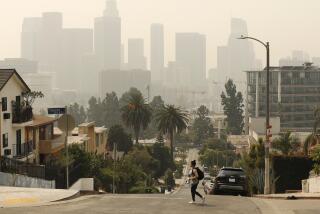EPA Attacked From 2 Sides on Asbestos
- Share via
WASHINGTON — The Environmental Protection Agency, in the first of its series of public hearings Tuesday on a proposed ban on asbestos, was lambasted by public health advocates for failing to move sooner to bar use of the cancer-causing substance and accused by the industry of whipping up hysteria over asbestos products.
In January the EPA proposed a halt in production of various asbestos roofing and flooring materials, clothing and cement pipe and fittings, while phasing out manufacturing, mining and processing of all asbestos over a 10-year period. EPA officials said that a decision on whether to adopt, modify or abandon the rule probably will be made late next summer. The agency estimates that asbestos dust causes 3,300 to 12,000 new cancer cases each year.
Calls for Asbestos Ban
Representatives of the White Lung Assn., a national, nonprofit asbestos-victims’ organization, told a panel of EPA scientists, lawyers and economists that millions of people are exposed to unacceptable levels of the insulating material in buildings across the country. They called for an immediate ban of all asbestos products.
“Someone dies every hour of asbestos-related disease,” said Marilyn Hunter, program administrator in Baltimore for the White Lung Assn. “Four more families are in mourning since I left home this morning.”
But B.J. Pigg, president of the Asbestos Information Assn. of North America, an industry group, blamed asbestos-related disease on improper handling of the material in the past. Industry has substantially lowered exposure in manufacturing and installation to “levels that pose risks no higher than those common in most workplaces,” he said.
Concedes Risks Continue
Pigg conceded that improper demolition of buildings containing asbestos and sloppy attempts to remove it continue to pose high risks. But today’s asbestos products contain the material in encapsulated form and its release “will not be significant if proper work practices are employed,” he said.
James Franklin Fite, executive director of the White Lung Assn., said that those who were exposed to asbestos in the 1950s and 1960s are only now becoming ill. “Our society has yet to see the effect of the large-scale application of asbestos on building surfaces which was widespread in the 1960s and 1970s,” he said.
Fite recalled attending a Senate hearing on asbestos regulation earlier this year and going to the Senate basement, where he saw “two workers strolling down a hallway littered with asbestos debris.” A study of the effects of asbestos could be done by monitoring the air quality and health records of employees in the Pentagon and the General Accounting Office, where asbestos was used in construction, he said.
Wants to Register Users
Fite called on the government to register users of asbestos and to levy special taxes on the purchase and sale of it.
“We must know where the product is, who owns it and what condition it is in . . . “ he said. “If the industry is held accountable for their actions, they will run from asbestos.”
Pigg and other industry representatives, however, told the EPA panel that asbestos substitutes are inferior in quality, more expensive and possibly even more dangerous than asbestos. “It is possible that substitution of other fibers for asbestos would increase, rather than diminish, risks to workers, and EPA has yet to assess seriously this possibility,” he said.
Instead of banning the material, industry called on the agency to impose stricter requirements for use and mandate warning labels on products.
More to Read
Inside the business of entertainment
The Wide Shot brings you news, analysis and insights on everything from streaming wars to production — and what it all means for the future.
You may occasionally receive promotional content from the Los Angeles Times.











